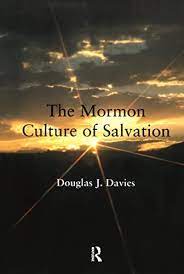Articles/Essays – Volume 36, No. 1
Mormonism, Death, Salvation, and Exaltation | Douglas J. Davies, The Mormon Culture of Salvation: Force, Grace and Glory
Douglas Davies “gets” Mormonism, as demonstrated by his latest book. This book is not his first. Mormon Spirituality: Latter-day Saints in Wales and Zion was published in 1987 and is also a must for scholars interested in understanding Mormonism. Davies approaches Mormonism from a unique point of view, one that de rives from his interest in death (see his Death, Ritual and Belief, published in 1997). The Mormon Culture of Salvation, he tells us, grew out of his interest and previous research on death. But this new book is about much more than death. The reader is continually drawn away on other adventures that reveal nuances of the Mormon experience that are not typically addressed in religious scholarship. For example, at one point Davies leads the reader into analysis of embodiment; exploring embodiment in relation to the temple, as well as in domestic (home and family) and community (ward) living. Later, in an attempt to describe the operation of power, charisma, and authority within the modern bureaucracy, he offers up various phrases as carriers of the root paradigm of Mormon authority: “the mantle,” “the keys,” “the brethren,” “the calling,” and “the Church,” “the Prophet,” “the Temple.”
Drawing from the embodiment literature of the social sciences, Davies argues that the body is central in the human process of self-understanding and that religion offers particular rituals, meanings, and behaviors to its adherents as markers of commitment, belonging, and authority. Borrowing from Pierre Bourdieu’s notion of habitus (a generative principle that under lies and expresses cultural practice), Davies focuses on four gestures: the temple garment, testimony giving, laughter, and voting (sustaining of officers in the church). These four, he argues represent a range of behaviors, “almost as a test of whether it is plausible to suggest that an underlying Mormon principle of life and action can be discerned” (p. 119).
Davies recognizes that one cannot fully capture the essence of Mor monism without articulating the significance of the temple and temple ritual. He knows he is dealing with sacred rituals and practices and remains objective and respectful in the process. He understands that in the symbolic sense the chapel is this worldly and “for time.” But the temple “mediates between time and eternity, between the pre-existence, earthly experience and the post-mortem realm of the afterlife” (pp. 73-74). For this rea son, Davies fills a significant gap in writings about the Mormon experience. For most scholars, the temple and its rituals are out of range, but Davies has been able to breach the walls of sacred space and to articulate within a social scientific framework why temples are central to the Mormon experience.
Many may argue with Davies’s hypothesis that the uniqueness of Mormon doctrine concerning death derives from Joseph Smith’s preoccupation with the death of his brother Alvin. Concern with the dead, he argues, led to the development of a theology that distinguished between salvation and exaltation, the creation of temple rituals that offered Latter-day Saints the opportunity to do temple work on be half of their deceased ancestors (including baptism for the dead), and beliefs that deceased Latter-day Saints were engaged in missionary activity in the spirit world. The significance of all this is that Mormonism affords a sense of transcendence over death “at a time when many Protestant, and even some Catholic, views of the afterlife are in decline. . .”(p. 103).
In the final chapters of the book, Davies addresses whether or not Mor monism has the potential to achieve the status of world religion. The question derives from Rodney Stark’s prediction that Latter-day Saint membership may reach upwards of 265 million by the year 2080. But Davies cautions that size of membership alone is insufficient for achieving world religion status. Mormonism may achieve world religion status to the extent that it possesses the key attribute shared by other religious movements: “a belief and ritual of death-conquest” (p. 5). His final chapter examines the footholds and footfalls inherent within Mor monism’s doctrines and practices that may or may not bring about world religion status.
This book is a must for anyone engaged in scholarship that places Mormonism on the landscape of religious studies. However, this is not a book without problems. The book is not a linear treatment—a logical progression from one point to another. Instead, it weaves a complex web, and sometimes that web takes the reader far afield. Davies is eclectic, using the writings of Max Weber, Marcel Mauss, Clifford Geertz, and Bourdieu. But if the reader doesn’t know who these theorists are and why their judgments are important, the points Davies wants to make may be lost. This is not a book for the uninformed: Davies writes to an audience that is well versed in the scholarship of comparative religion and religious studies.
The everyday life of Mormonism is slighted, as is the lived experience of women. Given the fact that he claims a phenomenological approach, the lack of attention to the lived experience of Mormonism is odd. He relies heavily on historical accounts and readily admits his extensive use of the Encyclopedia of Mormonism published by the church in 1992. Perhaps he should spend a few Sundays in a “real” ward with crying babies and nursing mothers, and he needs one or two visits to the Primary. Maybe then he would realize that the uniqueness of Mormonism’s culture of salvation is not just how it deals with death. Premortal existence and birth are as essential to understanding Mormon salvation and exaltation as is death. Because he focuses only on death, he captures only half the story. In the end, however, this book is innovative and makes an important contribution to scholarship on Mormonism.
The Mormon Culture of Salvation: Force, Grace, and Glory, by Douglas J. Davies (Aldershot, U.K.: Ashgate, 2000), 302 pp.


 Back to full Issue
Back to full Issue

